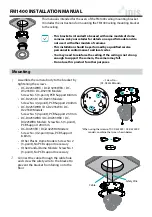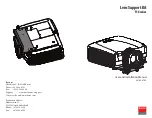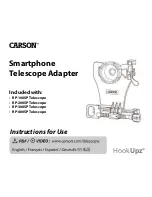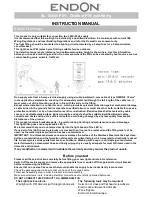
Page 3
• The width of the trailer and the location of the king pin in relation to
the “nose” (Dimension A), or leading edge of the trailer, is
critical
in
determining if your truck and trailer are compatible to be used with
a SuperGlide. If your king pin is located too far under the nose of
the trailer, the cam action of the SuperGlide may not move the trailer
back fast enough to allow the necessary clearance. Call PullRite
Customer Service at (800) 443-2307 with trailer width, make and year
of truck, and the distance of the king pin from the leading edge of the
trailer (Dimension A).
• Using a trailer that has a long rear slope to the king pin box hangar,
“B”, may cause damage to the king pin box or the inside edge of the
truck bed. Dimension “B” must be less than one half the width of the
inside top edges of the bed during turns for proper clearance.
• The SuperGlide hitch is equipped with a side-to-side pivot feature.
There should be a minimum of 6” between the truck bed rails
and the under side of the trailer for side tilt clearance. It is the
customers responsibility to adjust the trailer king pin box for the
appropriate amount of clearance depending on the terrain being
traveled (example: some State Parks are sloped and unpaved;
some driveways are steeply angled). If after-market bed covers are added, care must be taken to allow for additional
clearance.
• The SuperGlide hitch is designed to allow you to make a 90 degree turn. Please use extreme caution when turning
this far. In addition to putting stress on the wheels and axles of your trailer, if you make a turn greater than 90 degrees
the trailer will contact your truck and you WILL damage various parts of the hitch which will NOT be covered under the
Manufacturers Warranty.
• Position your brake-away cable so the slack in the cable will not be allowed to catch on the hitch during turns or lodge
in the cam mechanism. Failure to modify the length may cause the cable to catch on protruding parts of the hitch
which could activate the trailer brake, causing damage to the truck, trailer or hitch. Resulting damages will not be
covered by warranty.
• Position or coil any slack in your 7-way electrical cable out of the way of your moving hitch. It is preferred that the
plug and cabling remain isolated rearward of the hitch (nearest the tailgate) to prevent damage. Make slow test turns
while observing the 7-way cable until you are satisfied that it will not become caught in the hitch mechanism.
• FOREIGN DEBRIS
: Anything carried in the bed of your truck during towing will need to be well secured. Remove
any foreign debris that might move around in the bed and contact the hitch.
This will help to ensure that nothing
will get caught in or jam the movement of the cam which can cause damage to the hitch.
CAUTION
When you are assured your trailer is safely hooked up, pull forward and slowly start to turn. Make sure that someone is
outside watching the distance between the cab and the trailer. The distance between the cab and trailer should be greater
than two inches at all points of the turn. Specifically watch the distance when the corner of the trailer is closest to the cab
and also when nearing a 90 degree turn. The minimum two inches of clearance is needed for normal driving conditions.
The practice of testing clearance will let you know how much clearance you actually have should you encounter adverse
road conditions.
Example: It is possible for the trailer to hit the cab when turning through a dip where the corner of the trailer
is closest to the cab or when nearing a 90 degree turn.
TESTING CLEARANCE
B
A






































